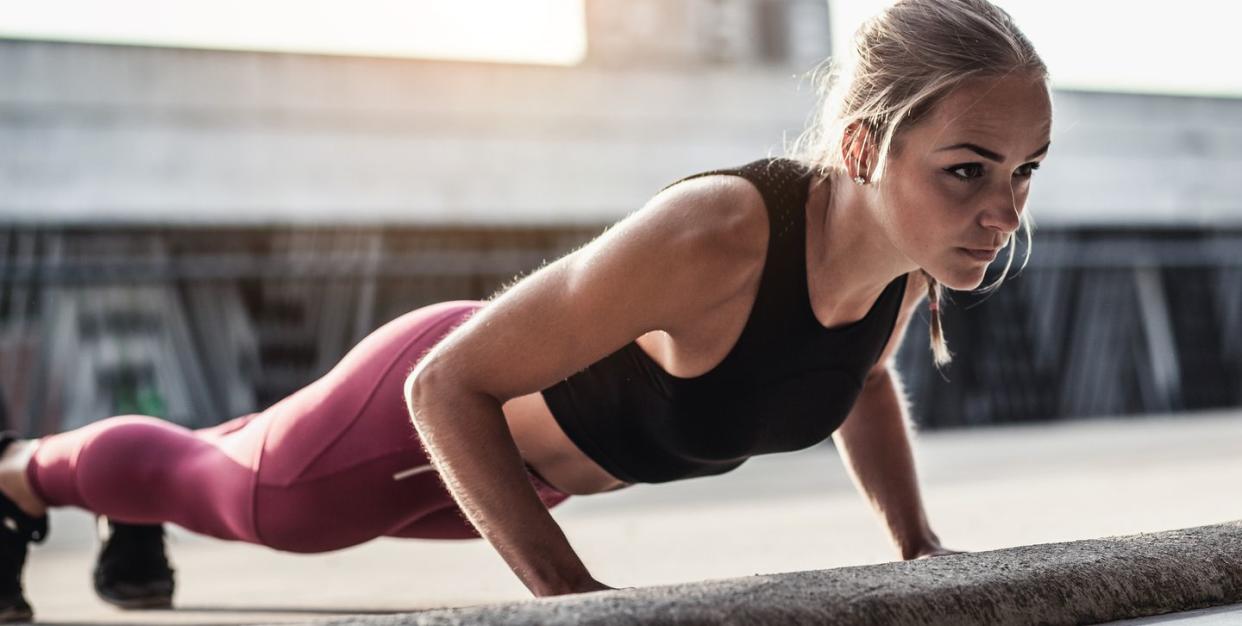6 Moves to Help You Master One of the Best Abs Exercises Out There

Mountain climbers are a great way to get your heart rate up and help build a super-strong core. And that, of course, is necessary to help stabilize your body when you’re on the bike.
“Mountain climbers always make their way into most at-home and group fitness exercise classes for two reasons,” Charlee Atkins, C.S.C.S., founder of Le Sweat, tells Bicycling. “They’re incredibly challenging, and when done correctly, they’re effective.”
But like anything, they will only help you if they’re done right. Ever finish a set and didn’t quite feel the burn you were expecting? While you may think of mountain climbers as a core exercise, you need sufficient upper and lower body strength to do them correctly—if you don’t, all the muscles that should be firing may not be.
Here’s how to do a mountain climber correctly:
Start in a high plank position, shoulders over wrists, core engaged so body forms a straight line from shoulders to hips to heels.
Engage your glutes and thighs to keep your legs straight.
Drive your left knee in toward your chest, then quickly step it back to plank position.
Immediately drive the right knee in toward chest, then quickly step it back into plank position.
As it turns out, you need to put in some prep work to build strength for proper mountain climber form.
This circuit from Atkins will help you do just that: This body-weight workout you can do anywhere will help you master the strength associated with completing successful mountain climbers by breaking down all of the components of the core-crushing exercise into separate elements.
“When forces all of these exercises are united into one, mountain climbers, we can see why this exercise is one of the best strength and cardio exercise you can do,” Atkins says.
How to do it: Perform the following exercises as a circuit, completing all of the prescribed reps (or the amount of time) for each before moving on to the next. Do the circuit three to five times, resting as needed between sets.
Push-Up
Mastering a push-up will give you the upper body strength needed to hold yourself in the position to complete the exercises. Start in push-up plank position, with shoulder over wrists, feet together and head in line with the heels. Then, lower down by “pulling” the entire body down. When the chest is about three to five inches from the ground, push right back up. Repeat. Complete 5 to 10 reps.
[Looking to start cross training but don’t know where to start? The Beginner’s Guide to Strength Training will teach you all the fundamentals to get the most out of your weight session, priming you for stronger miles in the saddle.]
Shoulder Taps
This move provides upper body balance and core stability. For mountain climbers, you need the right balance to be able to move one foot and then the other, plus core stability to support yourself.
Start in a push-up plank position, with shoulder right over the wrists, head in line with the heels and feet hip-width apart. Bring the opposite hand to the opposite shoulder. Remember to keep your body stable, so your hips don’t rock. Complete 10 to 20 reps total.
Plank Hold
This move works your core stability.
Start kneeling on all fours. Lie your forearms on the ground, palms facing down, so that your elbows are directly under shoulders. Engage your core, then step both feet back to a plank position. Your hips should be in line with shoulders so body forms a straight line from heels to head. Hold for 30 to 60 seconds.
Air Squat
This move will build leg strength—specifically, knee strength—and improve your ability to bend and extend the knee.
Start standing with feet hip-distance apart, toes pointed out slightly. Keeping a straight line from the head to the tailbone, lower down by bending the knees. Press the hips back, stop when thighs are parallel to the knee. Then, press feet into the ground and come back up to standing. Complete 10 to 12 reps.
Elevated Glute Bridge
Build hip strength—specifically in the glutes—and gain better balance.
Start with your feet on the ground and your back on a bench, keeping your neck neutral. (The bench should land right at the bottom of the shoulder blades.) Hold your arms out to the sides, resting on the bench. Lift your hips so your knees are at a 90-degree angle. While holding that position, bring one knee up in a marching position. Repeat on both legs. Complete 12 to 20 reps total.
Supine Hip Flexion
This mini-band exercise is great for hip flexor strength and mobility.
Place a mini-band with light resistance around the balls of the feet. Lay on your back, and with hands behind your head, come into a hollow body hold. Start with your knees bent at 90 degrees. Then, extend one leg out and focus on the pull of the foot in toward the chest. Repeat on both sides. Try to keep the knees at a 90-degree angle to the hips. Complete 12 to 20 reps total.
You Might Also Like